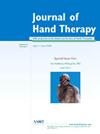一项定性调查,旨在探索认证手部治疗师对桡骨远端骨折的处理方法。
IF 2.1
4区 医学
Q2 ORTHOPEDICS
引用次数: 0
摘要
背景:桡骨远端骨折(DRF)在中老年人中极为常见。目的:本研究采用定性方法,对手部治疗师(CHT)的执业模式进行调查,以了解处理桡骨远端骨折的普遍常见模式:研究设计:描述性定性研究:本研究采用定性描述法和归纳法来了解中医师在处理 DRF 方面的做法。研究人员对在职中医进行了有目的的抽样调查。在半结构化访谈指南的指导下,采用开放式问题进行定性访谈,以评估中医在评估、干预和出院适宜性等方面的实践。两名学生物理治疗师对访谈内容进行了誊写,并由第三名评分者对其准确性进行了核实。主题内容分析指导了访谈数据的编码和分析。使用 Nvivo 软件进行了两个阶段的编码过程。两位研究作者编制了初始编码本,并完成了随后的记录分析:在 12 位参与者中,5 位是康复治疗师,7 位是康复治疗师,他们平均拥有 14.1 年的康复治疗师经验。CHT在各领域的实践模式基本一致。所有CHT均报告询问了DRF移位的严重程度、矫形管理、合并症和病史,并检查了腕部/手部的活动范围(ROM)、握力(GS)和腕部功能(n = 12)。大多数人都进行了结果测量,并进行了感官和皮肤评估。对患者进行有关损伤和锻炼的教育是干预的关键因素。GS、腕关节功能、腕关节ROM和使用腕关节/手完成功能性任务的能力的充分提高是出院护理的关键基准:讨论:在管理DRF时,大多数实践行为在CHT中都很常见。讨论:大多数 CHT 在处理 DRF 时的实践行为是共同的,但也存在一些差异,这取决于他们的主要学科是 PT 还是 OT。研究结果凸显了知识与行动之间的差距,即大多数护理长未将跌倒风险管理纳入 DRF:本研究发现了社区保健治疗师在处理 DRF 时的常见实践模式,同时也发现了通过整合平衡和跌倒风险评估来改进实践的机会。本文章由计算机程序翻译,如有差异,请以英文原文为准。
A qualitative inquiry to explore management of distal radius fracture by certified hand therapists
Background
Distal radius fractures (DRF) are extremely common in middle-aged and elderly. Certified Hand Therapists (CHT) are experts in managing hand injuries including DRF.
Purpose
Using qualitative methodology, this study examined practice patterns among CHT and understand prevalent common patterns in managing DRF.
Study design
Descriptive qualitative study.
Methods
This study utilized a qualitative descriptive method with an inductive approach to discern the practices of CHT in managing DRF. A purposive sample of practicing CHT was assembled. A semi-structured interview guide facilitated qualitative interviews using open-ended questions to assess practices of CHT in the domains of assessment, interventions, and appropriateness for discharge. Two student physical therapists transcribed the interviews, which were verified by a third rater for accuracy. Thematic content analysis guided the coding and analyses of the interview data. A two-phase coding process was conducted using Nvivo software. Two study authors developed initial codebook and completed subsequent analysis of transcripts.
Results
Of the 12 participants, five were PT and seven were OT with an average experience of 14.1 years as a CHT. Practice patterns across domains were largely consistent among CHT. All CHTs reported inquiring about severity of displacement of DRF, orthopedic management, comorbidities, and medical history as well as examining wrist/hand range of motion (ROM), grip strength (GS), and wrist functions (n = 12). A large majority administered outcome measures and performed sensory and integumentary assessment. Patient education regarding injury and exercises was the key element for interventions. Adequate gains in GS, wrist functions, wrist ROM, and ability to use wrist/hand for functional tasks were the key benchmarks for discharge from care.
Discussion
Most practice behaviors were common among CHTs while managing DRF. Some variations exist depending whether their primary discipline is PT or OT. The results highlight knowledge-to-action gap, where most CHTs do not integrate fall-risk management in DRF.
Conclusions
This study identified common practice patterns among CHTs in managing DRF while also identifying opportunity to improve practice by integrating assessment of balance and fall-risk.
求助全文
通过发布文献求助,成功后即可免费获取论文全文。
去求助
来源期刊

Journal of Hand Therapy
医学-外科
CiteScore
3.50
自引率
10.00%
发文量
65
审稿时长
19.2 weeks
期刊介绍:
The Journal of Hand Therapy is designed for hand therapists, occupational and physical therapists, and other hand specialists involved in the rehabilitation of disabling hand problems. The Journal functions as a source of education and information by publishing scientific and clinical articles. Regular features include original reports, clinical reviews, case studies, editorials, and book reviews.
 求助内容:
求助内容: 应助结果提醒方式:
应助结果提醒方式:


